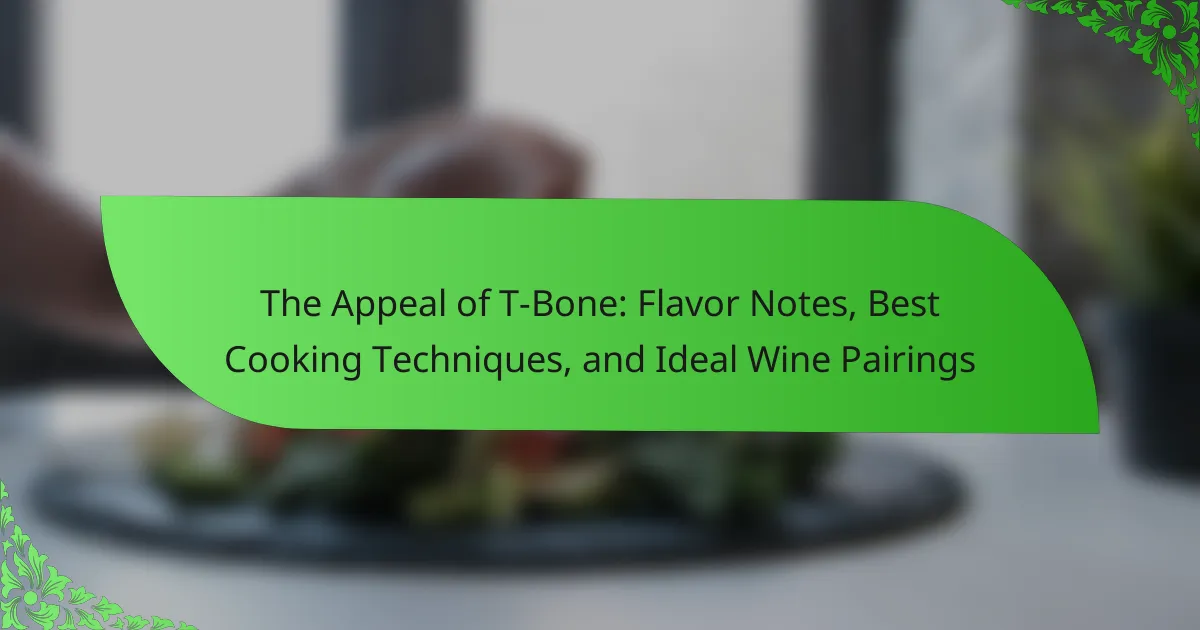T-Bone steak is a popular cut known for its rich flavor and tender texture, combining the strip steak and tenderloin. This article explores the appeal of T-Bone steak, focusing on its unique taste, ideal cooking techniques, and suitable wine pairings. Key cooking methods, such as grilling and broiling, are discussed to enhance its natural flavors, along with specific tips for achieving the perfect doneness. Additionally, the article highlights the importance of seasoning and resting the steak for optimal juiciness. Lastly, it suggests pairing T-Bone steak with full-bodied red wines to elevate the dining experience.

What Makes T-Bone Steak So Appealing?
T-Bone steak is appealing due to its rich flavor and tender texture. It features a unique combination of two cuts: the strip steak and the tenderloin. This duality offers a variety of tastes and textures in each bite. The marbling in T-Bone steak contributes to its juiciness and enhances the overall flavor profile. Additionally, its size makes it ideal for sharing or serving as a hearty meal. Cooking techniques such as grilling or broiling elevate its natural flavors, resulting in a delicious char. The T-Bone is also versatile for pairing with various wines, enhancing the dining experience. These attributes collectively contribute to its popularity among steak enthusiasts.
What are the distinctive flavor notes of T-Bone steak?
T-Bone steak has distinctive flavor notes that include rich, beefy umami and subtle sweetness. The flavor profile is enhanced by the marbling of fat, which contributes to its juiciness. The tenderloin side offers a milder taste, while the strip side delivers a bolder, more robust flavor. When cooked, the Maillard reaction creates caramelized notes that add complexity. The steak’s seasoning, often with salt and pepper, further elevates its natural flavors. Grilling or broiling intensifies the smoky undertones, making it a popular choice among steak enthusiasts.
How do the different cuts of T-Bone contribute to its flavor?
The different cuts of T-Bone contribute to its flavor through their distinct textures and fat content. The T-Bone steak consists of two cuts: the tenderloin and the strip loin. The tenderloin offers a buttery softness due to its low-fat content. This results in a mild flavor that is often described as delicate. The strip loin, on the other hand, has more marbling. This marbling enhances its flavor, providing a rich, beefy taste.
When cooked, the fat in the strip loin melts and infuses the meat with juiciness. The combination of both cuts creates a balance of tenderness and robust flavor. The cooking method also influences flavor; grilling or broiling enhances the natural beef flavors through caramelization. Thus, the distinct cuts of T-Bone each contribute uniquely to the overall flavor profile of the steak.
What role does marbling play in the taste of T-Bone steak?
Marbling significantly enhances the taste of T-Bone steak. Marbling refers to the intramuscular fat found within the meat. This fat melts during cooking, imparting moisture and richness to the steak. The presence of marbling contributes to a more tender texture. Studies show that well-marbled beef is often rated higher in flavor and juiciness. The USDA grading system reflects this, with higher grades indicating better marbling. Overall, marbling plays a crucial role in the overall eating experience of T-Bone steak.
What cooking techniques enhance the flavor of T-Bone steak?
Grilling and pan-searing enhance the flavor of T-Bone steak. These techniques create a Maillard reaction, which develops rich, savory flavors. Grilling allows for smoky undertones, while pan-searing provides a crispy crust. Both methods retain the steak’s natural juices. Using high heat is essential for optimal results. Additionally, resting the steak post-cooking lets juices redistribute, enhancing tenderness. Seasoning with salt and pepper before cooking intensifies flavor. Overall, these techniques ensure a flavorful and satisfying T-Bone steak experience.
How does grilling affect the taste and texture of T-Bone steak?
Grilling enhances the taste and texture of T-Bone steak by creating a flavorful crust and tenderizing the meat. The high heat of grilling caramelizes the natural sugars in the steak, adding a smoky flavor. This process also generates Maillard reaction compounds, which contribute to the rich, savory taste. The intense heat seals in juices, resulting in a moist interior. Grilled T-Bone steak typically has a firmer texture due to the searing process. Studies show that grilling can reduce fat content while maintaining flavor. This cooking method is favored for its ability to enhance the overall dining experience.
What are the best methods for pan-searing T-Bone steak?
The best methods for pan-searing T-Bone steak include using a cast-iron skillet and high heat. Start by seasoning the steak with salt and pepper. Preheat the skillet over medium-high heat until it is very hot. Add a small amount of oil with a high smoke point, like canola or avocado oil. Place the steak in the skillet and sear for about 4-5 minutes on each side for medium-rare. Use a meat thermometer to ensure it reaches an internal temperature of 130-135°F. Let the steak rest for a few minutes before slicing to retain juices. This method enhances the steak’s flavor through the Maillard reaction, creating a delicious crust.
How can sous-vide cooking improve the quality of T-Bone steak?
Sous-vide cooking can significantly enhance the quality of T-Bone steak by ensuring precise temperature control. This technique allows the steak to cook evenly throughout, preventing overcooking. The low and slow cooking method retains moisture, resulting in a juicier steak. Additionally, sous-vide enhances flavor infusion when marinated. The vacuum-sealed environment allows the steak to absorb seasonings more effectively. Studies show that sous-vide cooking can improve tenderness by breaking down collagen without drying out the meat. This method also allows for consistent results, eliminating variability in cooking times. Overall, sous-vide cooking elevates the T-Bone steak experience by maximizing flavor and texture.
What are the ideal wine pairings for T-Bone steak?
The ideal wine pairings for T-Bone steak are bold red wines. Cabernet Sauvignon is a popular choice due to its high tannins. The tannins complement the rich flavors of the steak. Malbec is another excellent option, offering fruitiness and depth. Syrah/Shiraz also pairs well, enhancing the steak’s savory notes. These wines have enough body to stand up to the meat’s richness. The ideal temperature for serving these wines is around 60-65°F. This enhances their flavor profile alongside the T-Bone steak.
Which red wines complement the flavors of T-Bone steak best?
Cabernet Sauvignon and Malbec are the best red wines that complement T-Bone steak. Cabernet Sauvignon has bold tannins and rich fruit flavors. This wine enhances the steak’s savory and juicy qualities. Malbec offers a fruit-forward profile with a smooth finish. It balances the meat’s richness without overpowering it. Both wines have acidity that cuts through the fat of the steak. This pairing creates a harmonious dining experience. Studies show that tannins in red wine can enhance the perception of meat flavors.
What factors should be considered when choosing a wine for T-Bone steak?
When choosing a wine for T-Bone steak, consider the wine’s body, acidity, and tannin levels. A full-bodied red wine complements the richness of T-Bone steak. Wines like Cabernet Sauvignon or Malbec have the structure to match the steak’s flavors. The acidity in the wine helps cut through the fat of the meat. High tannin levels in red wines enhance the overall taste experience. Pairing wine with the steak’s seasoning and preparation method is also essential. For grilled T-Bone, a smoky wine can enhance the flavor profile. Matching the intensity of the wine with the dish elevates the dining experience.

How Can You Perfectly Cook a T-Bone Steak?
To perfectly cook a T-Bone steak, start by bringing the steak to room temperature. This ensures even cooking throughout. Season the steak generously with salt and pepper on both sides. Preheat your grill or skillet to high heat for a good sear. Place the steak on the heat source and cook for 4-5 minutes on each side for medium-rare. Use a meat thermometer to check the internal temperature, aiming for 130-135°F. Let the steak rest for at least 5 minutes before slicing. This allows the juices to redistribute. Following these steps yields a flavorful and tender T-Bone steak.
What are the essential steps for preparing T-Bone steak?
To prepare T-Bone steak, start by selecting a high-quality cut. Ensure the steak is at room temperature before cooking. Season it generously with salt and pepper on both sides. Preheat your grill or skillet over high heat. Sear the steak for 4-5 minutes on each side for medium-rare. Use a meat thermometer to check for an internal temperature of 130-135°F. Allow the steak to rest for 5-10 minutes after cooking. This resting period helps retain juices, enhancing flavor and tenderness. Slice against the grain before serving for the best texture.
How should T-Bone steak be seasoned before cooking?
T-Bone steak should be seasoned with salt and pepper before cooking. This simple seasoning enhances the natural flavor of the meat. Use coarse kosher salt for even distribution. Freshly ground black pepper adds a bit of spice. Season both sides of the steak generously. Let the seasoned steak rest for about 30 minutes before cooking. This allows the salt to penetrate the meat. Proper seasoning is crucial for a well-cooked steak. It helps create a flavorful crust during the cooking process.
What is the recommended cooking temperature for T-Bone steak?
The recommended cooking temperature for T-Bone steak is 145°F (63°C) for medium rare. Cooking to this temperature ensures that the steak is juicy and tender. It is essential to use a meat thermometer for accuracy. The USDA advises this temperature for safe consumption. Cooking at this temperature allows the flavors to develop fully. It also helps maintain the steak’s moisture content. Cooking beyond this temperature may result in a drier texture. Therefore, monitoring the temperature is crucial for optimal results.
What common mistakes should be avoided when cooking T-Bone steak?
Common mistakes to avoid when cooking T-Bone steak include not allowing the steak to rest before cooking. This can lead to uneven cooking and loss of juices. Another mistake is cooking it straight from the refrigerator. A room temperature steak cooks more evenly. Overcooking is also a frequent error. T-Bone steak is best served medium-rare to maintain its flavor and tenderness. Using inadequate seasoning can result in bland taste. Proper seasoning enhances the steak’s natural flavors. Lastly, cutting the steak before it rests allows juices to escape. Resting helps retain moisture for a juicier result.
Why is it important to let T-Bone steak rest after cooking?
Letting T-Bone steak rest after cooking is important to retain its juices. During cooking, the juices move toward the steak’s surface. Resting allows the juices to redistribute throughout the meat. This process results in a more flavorful and moist steak. If cut immediately, the juices escape, leading to dryness. Research indicates that resting meat can improve tenderness and overall quality. A resting period of 5 to 10 minutes is generally recommended for optimal results.
How can overcooking affect the quality of T-Bone steak?
Overcooking T-Bone steak significantly reduces its quality. It results in a tougher texture due to the breakdown of proteins. The meat loses its natural juices, leading to dryness. Overcooked steak also lacks the desirable flavor profile. Ideal doneness enhances the steak’s rich taste, which is diminished when overcooked. According to the USDA, cooking beef beyond 160°F alters its tenderness and moisture retention. This temperature threshold is crucial for maintaining quality in T-Bone steaks.

What Additional Tips Enhance Your T-Bone Steak Experience?
To enhance your T-bone steak experience, consider proper seasoning and cooking techniques. Use a generous amount of salt and pepper to bring out the flavor. Let the steak rest at room temperature for about 30 minutes before cooking. This helps in even cooking. Preheat your grill or pan to high heat for a good sear. Searing locks in juices and adds flavor. Cook the steak to your desired doneness, using a meat thermometer for accuracy. Aim for 130°F for medium-rare. Let the steak rest for 5-10 minutes after cooking. This allows the juices to redistribute, making it more tender. Pair your steak with a full-bodied red wine like Cabernet Sauvignon for a complementary flavor.
What side dishes pair well with T-Bone steak?
Baked potatoes pair well with T-Bone steak. They provide a hearty side that complements the steak’s richness. Creamy mashed potatoes are another excellent choice. Their smooth texture enhances the overall dining experience. Grilled asparagus adds a fresh, vibrant element. The slight char from grilling pairs beautifully with the meat. A classic Caesar salad offers a crisp contrast. The dressing adds a tangy flavor that balances the steak. Sautéed mushrooms can enhance the umami profile of the dish. Their earthy flavor complements the steak’s savory notes. Finally, roasted Brussels sprouts provide a nutty crunch. This variety of side dishes enhances the enjoyment of T-Bone steak.
How can sauces enhance the flavor profile of T-Bone steak?
Sauces can significantly enhance the flavor profile of T-Bone steak. They add layers of taste that complement the meat’s natural richness. For instance, a classic béarnaise sauce introduces a creamy, herbaceous element. This contrasts beautifully with the steak’s savory notes. A chimichurri sauce brings a fresh, zesty flavor that brightens the dish. This sauce’s acidity cuts through the fat, balancing the overall taste. Additionally, barbecue sauces can add sweetness and smokiness, creating a bold flavor experience. Marinades can also infuse the steak with spices and herbs before cooking. This results in a more complex flavor profile. Overall, sauces enrich the dining experience by enhancing and diversifying the inherent flavors of T-Bone steak.
What are the best practices for storing leftover T-Bone steak?
Store leftover T-Bone steak in an airtight container. This prevents moisture loss and protects against odors. Refrigerate the container within two hours of cooking. The USDA recommends consuming refrigerated steak within three to four days. For longer storage, freeze the steak. Wrap it tightly in plastic wrap, then in aluminum foil. This method helps prevent freezer burn. Frozen T-Bone steak can last up to six months in the freezer. Always thaw frozen steak in the refrigerator, not at room temperature. This ensures safety and maintains quality.
How can you reheat T-Bone steak without losing flavor or texture?
To reheat T-Bone steak without losing flavor or texture, use a low and slow method. Place the steak in a baking dish and cover it with aluminum foil. Preheat the oven to 250°F (121°C). Heat the steak for about 20-30 minutes, checking for an internal temperature of 130°F (54°C) for medium-rare. This method preserves moisture and prevents overcooking. A study by the USDA shows that reheating meat at lower temperatures retains more juiciness compared to high heat methods. This approach ensures that the steak remains tender and flavorful.
The main entity of this article is the T-Bone steak, renowned for its rich flavor and tender texture. The article explores its appealing attributes, including the unique combination of strip steak and tenderloin, the role of marbling in enhancing taste, and effective cooking techniques such as grilling and pan-searing. It also highlights ideal wine pairings that complement the steak’s robust flavors, alongside tips for perfect preparation and common mistakes to avoid. Additionally, the article provides guidance on storing and reheating leftover T-Bone steak to maintain its quality.
